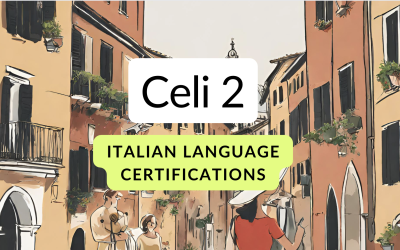Blog
L’Esame B1 per la Cittadinanza
A causa delle modifiche alla legge italiana del...
27 Popular Italian Shows on Netflix to Improve your Italian Fluency in 2025
Watch Italian Shows From Anywhere Can't access...
Master Italian Particles: How to Use ‘CI’ and ‘NE’ Correctly (with Examples)
What are CI and NE in Italian?...
Gli, Le, Ti, Vi: Decoding Italian Indirect Object Pronouns (Pronomi Indiretti)
What is an indirect pronoun in Italian? An...
22 Short Stories in Easy Italian
What's a short story in Italian? A short story...
11 Short Stories in Italian For Intermediate Learners
If reading in Italian has become too challenging...
7 Great Italian Textbooks to Expand your Vocabulary
Having a good vocabulary in Italian is a strong...
Mastering Italian: Comprehensive Guide to Conjunctions
Italians are quite wordy and love stringing...
Teacher’s Guide: Find the Best Italian Language App
The use of apps for learning Italian is on the...
What does “Stare per” mean in Italian?
What does "Stare per" Mean in Italian? The...
Why getting an Italian Language Certification is a great idea and how to do it
If you are a big fan of the lingua di...
Writing Formal or Informal Emails for your Italian Citizenship Exam
If you’re preparing for your Italian Citizenship...
Teacher’s Guide: Italian Verbs with Double Auxiliaries
Italian Verbs with Double Auxiliaries Examples:...
How to get your CELI 2 certification
What is the CELI 2? The CELI 2 is an official...
How to Use the Expression ‘Mi tocca’
Toccare - to touch Have you ever heard or read...
9 Very Common Filler Words in Italian
Once I heard an American saying that we Italian...
What’s the CILS Uno B1? (Italian Language Certification)
What is the CILS Uno B1? The CILS Uno B1 is an...
Cils Exam Centres
Accredited Cils Exam Centers This is a list of...
How to Say ‘How’ in Italian
1. Come The most frequent translation of 'how'...
How to Read a Book in Italian
Did you know that reading in one's first...
Beato me! Beati loro! But.. what does it mean?
How to use the word "beato" in Italian The...
Giorno and Giornata: What’s the Difference?
Giorno vs. Giornata Today I want to explore one...
How To Speak and Understand Better Italian With Italian Short Stories
Why Using Italian Short Stories To Speak Italian...
Mastering Italian: Fa Bene/Fa male
This article will explain the meaning and use of...
Trovare and trovarsi. The difference.
Trovare and trovarsi: what's the difference?...
Learning Italian with a self-paced online course (Rocket Languages Review)
Learning Italian with a self-paced online...
How to say “how long have you been doing something” in Italian
In Italian, to ask how long someone has been...
Vocabulary to Rent an Apartment in Italy
Renting an apartment in Italy can be...
Essential Phrases to Say if You’re Sick in Italian
What to say when you're sick in Italian? Whether...
Italian Language Schools in Sicily (How to Choose)
4 Italian Language Schools in Sicily DisclaimerI...
How to say ‘thank you’ in Italian
Gratitude goes hand in hand with good manners,...
Italian Future Tense: A Simple Guide
The future tense: Italian vs. English The most...
6 Great Italian Writers to Explore the Italian Modern Literature
We all learn a foreign language because we want...
Italian Sentence Structure
Subject–Verb–Object in Italian Sentence...
CILS B1 for Citizenship Exam: The Structure
What's the CILS B1 for Citizenship (Cils B1...
Best Free Tools to Improve Your Italian Listening
Why Tuning up Italian Italian Listening Skills...
What do “Qualsiasi” e “Chiunque” mean?
Qualsiasi (Any) Qualsiasi is one of those...
17 Unexpectedly Creative Methods to Learn Italian
The creative adult is the child who...
How to use the verb ‘Mettersi’
Mettersi is an Italian verb that non-native...
Dire and Parlare: The Difference
How do you say 'to talk' in Italian? Is it...
Passato Prossimo in Italian: Conjugation Rules and How to Use It (The Main Italian Past Tense)
What Is the Passato Prossimo? The passato...
Understanding the Differences: ‘Finalmente’, ‘Alla Fine’, and ‘Infine’ in Italian
What is the difference between 'finalmente',...
Is Sicilian a Language?
If you are a passionate Italophile, the odds are...
Italian Present Conditional (Condizionale Presente)
How to Use the Italian Present Conditional...
15 Italian Tongue Twisters to Improve Your Pronunciation
Italian is generally straightforward to read,...
What’s The Difference Between ‘Dovevo’ and ‘Ho Dovuto?’
If you ended up on this page, it's because you...
46 Italian phrases related to Yoga
If you like yoga and you are learning Italian,...
Mastering Italian: Most Common Phrases with the Verb ‘Fare’
Besides being an irregular verb, the verb 'fare'...
How to make a phone call in Italian
Making a phone in Italian call can be daunting ,...
CILS B1 for Citizenship – The Listening Part
The Exam Structure Here's a breakdown of the...
Migliore and Meglio: The Difference
Migliore vs. Meglio "Migliore" and "meglio" are...
Direct Object Pronouns in Italian (Pronomi Diretti)
What’s a Pronoun? Pronouns are little words that...
Anch’io vs. Anche a me (Neanch’io vs. Neanche a me) – The Difference
Anch'io vs. anche a me: the difference "Anche"...
Mi Serve or Mi Servono? Learn How to Use Servire Correctly
So, What Does Mi Serve Mean? Mi...
Italian Past Conditional (Condizionale Passato)
What is the Past Conditional in Italian? In...
Riuscire and Potere. The Difference.
In my experience as an Italian language teacher,...
Italian Noun Gender. Determining Masculine vs. Feminine
Nouns ending in '-o' or '-a' In Italian...
Italian Prepositions: How To Use “In”and “A”
In or A? One of the most common mistakes in...
Italian Impersonal Form
The impersonal form with "si" In Italian, we...
Common expressions using ESSERE and AVERE
In Italian, the verbs essere and avere are...



























































